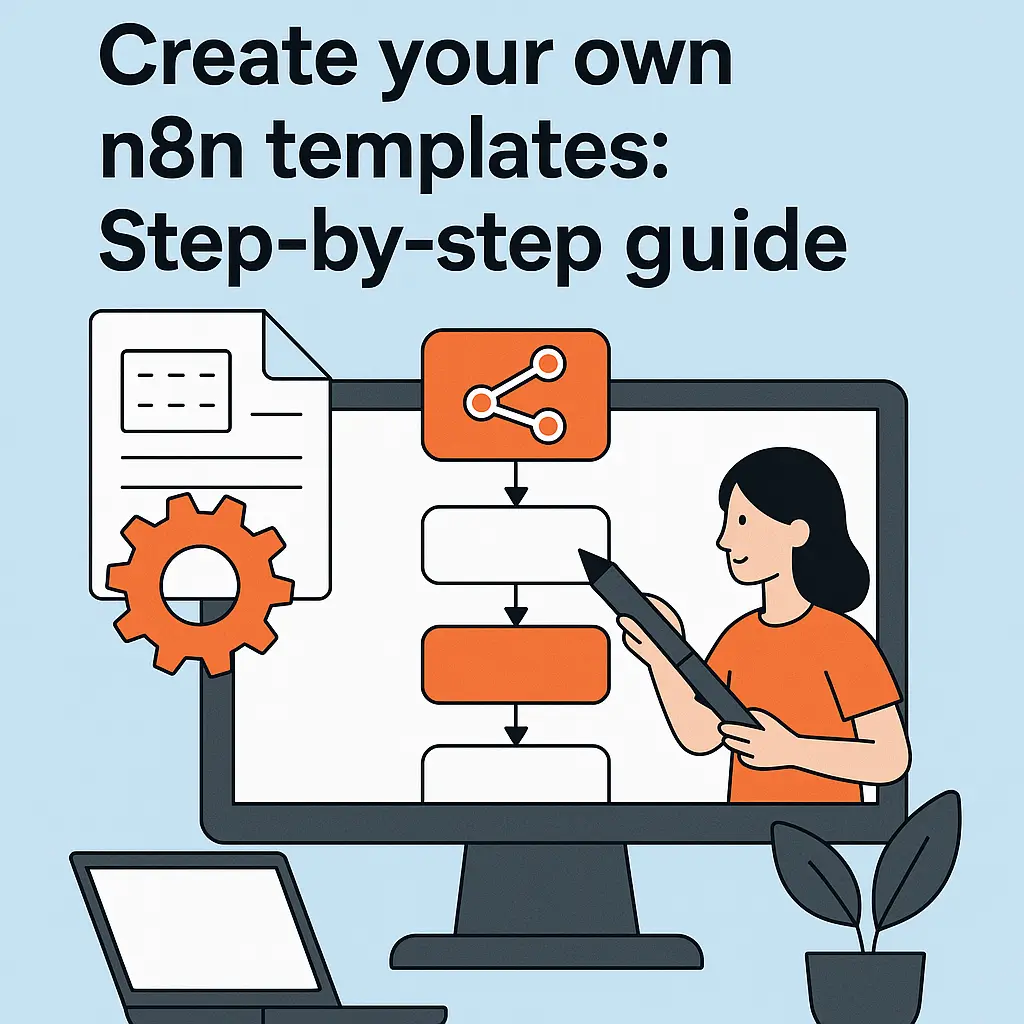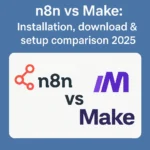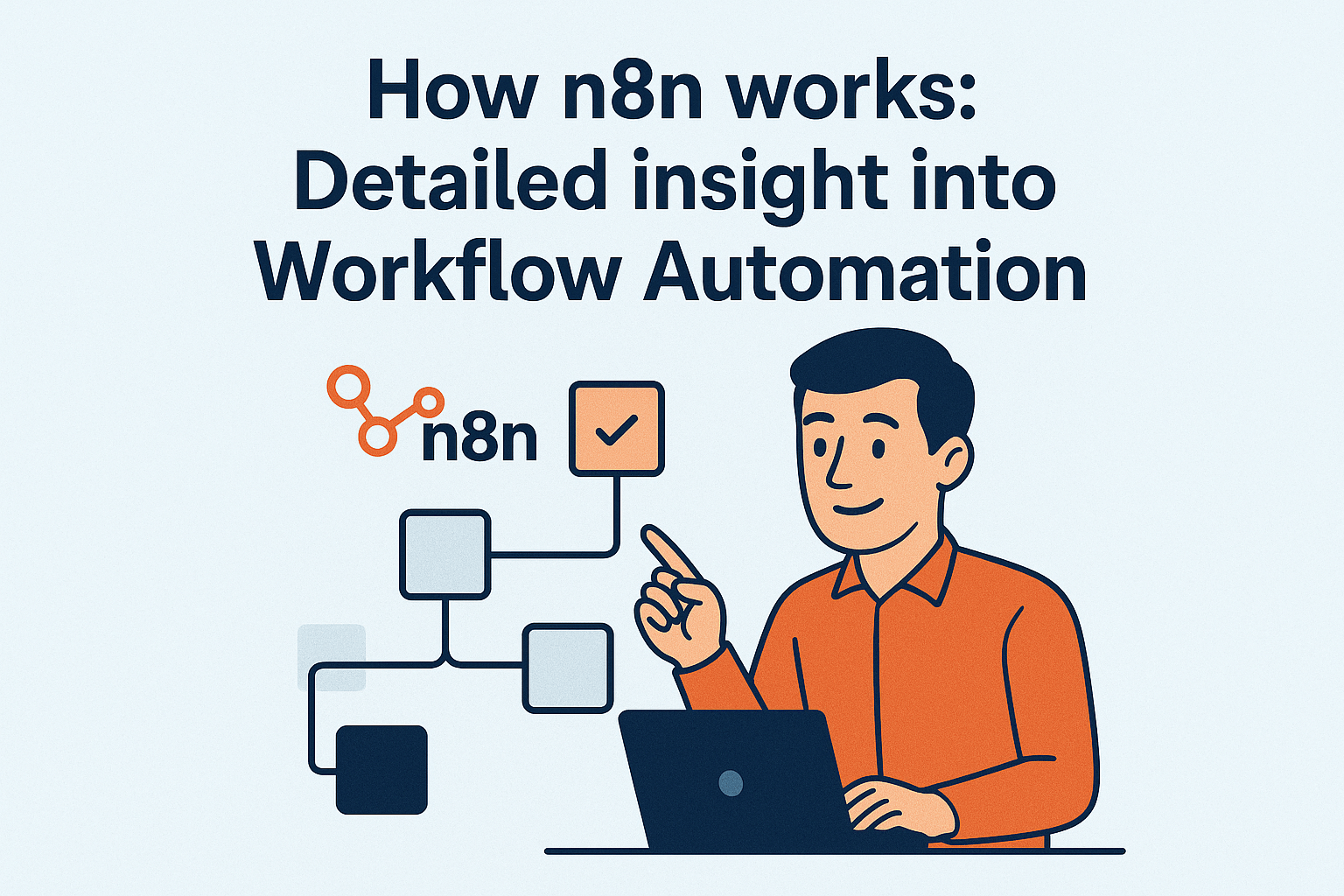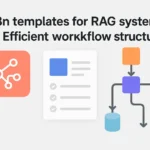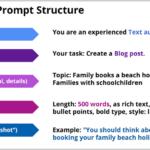In this guide, you will learn how to create your own n8n templates to standardize workflows for you and your team and save time. These templates are particularly valuable if you regularly set up similar automations.
- Templates are reusable workflow blueprints that make your most productive n8n automations available for quick deployment in different projects.
- The template creation process starts with a working workflow, which you should fully test before exporting it to the JSON structure that serves as the basis of the template.
- Detailed documentation is crucial to the usability of your template – make sure you have clear instructions on installation, configuration and any required credentials.
- Use variables instead of fixed values to make your template flexible and customizable for different environments without users having to dig deep into the code.
- Share your templates with the community via the n8n website or GitHub to benefit from feedback and strengthen your expert status in the automation community at the same time.
Dive into the full guide now to learn step-by-step how to create and publish your first professional n8n templates.
Tired of the same old workflows in n8n and want to finally build automations that fit your marketing or product? Then you’ve come to the right place.
With your own n8n templates, you can save a huge amount of time, reduce recurring errors – and take your setup to the next level. Especially in marketing or growth campaigns, this means more freedom for real creativity and less copy-paste fiddling.
But how do you build an n8n template that is truly reusable and team-friendly? With the right steps, it’s super easy – we promise. We’ll show you how to keep everything so simple and transparent, from the initial idea to variables and modularization to the finished JSON, that even colleagues from non-tech teams can get started right away.
What you can expect right away:
- Practical checklist that you can copy 1:1
- 💡Tip boxes with professional tricks from real projects
- Step-by-step instructions incl. screenshots & code snippets
- Mini FAQs for typical stumbling blocks
- Direct links to glossary & official docs
Plain text instead of technical jargon: We don’t assume that you are an n8n guru – but that you want impact. And don’t worry: we leave no gaps when it comes to data protection and fairness.
Let’s get started: Together, we’ll build your first n8n template that can do more than standard solutions – and that you can share directly with your team.
What are n8n templates and why should you create your own?
n8n templates are ready-made workflow modules that pack complex automation tasks into reusable formats. They act as digital blueprints that you can import directly into your n8n instance and adapt to your needs.
Definition and basics of n8n templates
An n8n template consists of a JSON-based workflow definition that contains all nodes, connections and configurations. This structured file stores:
- Node configurations with specific settings
- Data flow connections between individual building blocks
- Credential references for external services
- Error handling logic and branches
Official templates come from n8n’s curated library and go through a quality check process. Custom templates are created from your own workflows and can contain organization-specific logic.
Why create your own templates?
Developing your own templates solves four key challenges:
- Organization-specific requirements: Internal APIs, proprietary data formats and special compliance rules can only be mapped using customized templates
- Workflow standardization: Repeated automation patterns such as customer notifications or data validation become consistent, error-free building blocks
- Team efficiency: colleagues can use proven solutions immediately without having to develop workflows from scratch
- Compliance security: data protection and security guidelines are built directly into templates and automatically enforced
💡 Tip: Template development pays off from the third time you create a similar workflow
Investing in your own templates pays off by reducing development time by 30 to 60 percent. Teams report significantly fewer errors and faster onboarding times for new employees, as proven automation templates are immediately available.
Preparation: Set up the development environment
The right development environment is the cornerstone for professional n8n template development. A clean Docker-based installation combined with the right tools reduces debugging time by up to 50 percent and enables consistent template development.
Self-hosted n8n installation
Docker provides the most stable development environment for template development. The following command starts a complete n8n instance with persistent storage:
docker run -it --rm --name n8n -p 5678 (as of: 2025):5678 (as of: 2025) -v ~/.n8n:/home/node/.n8n n8nio/n8n
Prepare template hosting
For your own templates, you need a Strapi-based hosting infrastructure. Strapi replicates the official n8n template API and enables seamless integration:
- Node.js version 14 or higher is mandatory
- PostgreSQL or MySQL for production environments
- At least 2 GB RAM for stable performance
The basic installation is done via:
npx create-strapi-app@latest template-host --quickstart
Essential Development Tools
These tools will speed up your template development considerably:
- Visual Studio Code with JSON schema validation
- Postman for API testing of template endpoints
- Git for version control and collaborative development
- Docker Compose for multi-container deployments
Configure environment variables
Set these critical variables for template hosting:
N8N_TEMPLATES_HOST=http://localhost:1337 (as of 2025) N8N_TEMPLATES_ENABLED=true N8N_TEMPLATES_CACHE_TTL=3600 (status: 2025)
💡 Tip: Use separate development and production environments. Templates in development should never be used directly in production workflows.
A correctly configured development environment eliminates 80 percent of the most common template development problems and enables professional workflow automation right from the start.
Step-by-step: template creation in practice
Practical template creation in n8n follows a three-stage approach that leads from conceptual planning to the export-ready template. Each stage systematically builds on the previous one and ensures that your template is both functional and reusable.
Phase 1: Workflow design and planning
First, define the automation area of your template through the three core components:
- Trigger configuration: webhook, scheduler or manual triggering
- Processing logic: data transformation and business logic
- Output handling: forwarding, storage or notification
Implement error handling as a standard component in every template workflow. Connect critical nodes with error response nodes that return structured error messages. This prevents users from being left in the dark when template errors occur.
💡 Tip: Plan at least 30 percent of your development time for robust error handling.
Phase 2: Structure and optimize the template
Use meaningful node names such as “JSON Parse Customer Data” instead of generic names such as “Function”. This makes it much easier for other developers to understand your template.
Develop a modular workflow architecture:
- Grouping related nodes into logical blocks
- Using note nodes for documentation
- Clear data flow paths without branches
Credential management requires special attention: use environment variables instead of hard-coded access data and document all required authorizations in the template.
Phase 3: JSON export and metadata enhancement
Export your template via the n8n interface(Workflow → Export → Download JSON) or via command line for automated deployments: n8n export:workflow --id=Workflow_ID.
Add template-specific metadata to the JSON that categorizes the template in the n8n library:
Copy & Paste Prompt Box: template metadata structure
"template": {
"name": "Your template name",
"description": "Description of the functionality",
"categories": ["Marketing", "Automation"],
"version": "1.0"
}
Validate your template against n8n standards by checking the schema via api.n8n.io/schema. This ensures compatibility with future n8n versions and prevents import problems.
This systematic approach reduces template development time by an average of 40 percent and significantly increases the success rate of the first implementation.
Template hosting: building your own infrastructure
Having your own template infrastructure gives you complete control over your n8n workflows and enables organization-wide standardization. It is primarily set up using Strapi as a content management system that perfectly replicates n8n’s template API.
Strapi server for template hosting
Strapi serves as the ideal hosting platform for n8n templates as it natively supports the required API structure. The implementation requires a precise schema replication of the official n8n template API.
The essential endpoints for a functional template integration are:
/templates/categories– category taxonomy for template filtering/templates/search– Searchable template database with metadata/templates/workflows/{id}– Single template query with complete workflow data
Deployment strategies differ depending on requirements: Strapi Quickstart is suitable for quick prototypes, while Custom Setup is essential for productive environments with specific security requirements.
Docker-based deployment solution
Container orchestration significantly simplifies template hosting. The persistent storage configuration is carried out using mounted volumes that permanently store both n8n data and template files.
Critical environment variables for template integration:
N8N_TEMPLATES_HOST=http://strapi:1337 (status: 2025)N8N_TEMPLATES_ENABLED=trueN8N_TEMPLATES_CACHE_TTL=3600 (status: 2025)
Template publishing workflow
Internal distribution works via JSON files in the mounted volumes. Templates are automatically registered via webhooks as soon as new files appear in the monitored directory.
The user access configuration determines template visibility based on user roles and organizational permissions. Templates automatically appear in n8n’s template tab after server restart.
💡 Tip: Template hosting reduces deployment time by up to 70 percent for organization-wide adoption.
A separate template host offers maximum flexibility for company-specific workflows and ensures compliance with internal security guidelines.
Practical example: Developing a JSON validator template
The JSON valid ator template is an example of how to develop a robust, reusable workflow for API validation. This template validates incoming JSON payloads via webhooks and returns structured error reports.
Requirements analysis and workflow design
The workflow starts with a webhook trigger on the path /validate-json. Configure the trigger with the following parameters:
- HTTP method: POST for JSON payload transmission
- Authentication: API key-based authentication
- Response mode: Immediate for synchronous responses
You implement the validation logic with a function node that performs JSON schema validation:
// Basic validation for JSON structure
const payload = $json.body;
const isValid = typeof payload === 'object' && payload !== null;
return [{ isValid, errors: isValid ? [] : ['Invalid JSON structure'] }];
Implementation and testing
Node configuration step-by-step:
- Webhook node: Set the path to
/validate-jsonand activate “Respond to Webhook” - Function node: Implement schema validation with try-catch for robust error handling
- IF node: Branches based on validation result
💡 Tip: Use the ajv package for extended JSON schema validation directly in the function node
You createtest payloads systematically:
- Valid JSON:
{"name": "Test", "value": 123} - Invalid structure:
{"name": "Test", "value": "invalid"} - Malformed JSON:
{"name": "Test", "value":}
Deployment and documentation
Template export takes place via Workflow → Export → Download JSON. Add the metadata in the JSON:
"template": {
"name": "JSON Validator API",
"description": "Validates JSON payloads with structured error reporting",
"categories": ["Development", "API", "Validation"],
"version": "1.0.0"
}
The user manual documents the webhook URL, expected payload structure and response examples. Integrate a feedback system via a separate webhook for continuous improvement.
This template reduces development time for API validation by about 70 percent and standardizes error handling team-wide.
Debugging and troubleshooting
Template development in n8n brings with it specific challenges that can be solved with systematic approaches. Proactive error handling and structured debugging methods reduce development time by up to 40 percent.
Systematically eliminate host configuration errors
Connectivity tests form the basis for successful template hosting. Use these commands for diagnostics:
curl -I http://localhost:1337 (status: 2025)/health– check strapi server statuscurl -v http://localhost:1337 (as of: 2025)/templates/categories– Test API endpoint availabilitydocker logs n8n-container– Check container logs for network errors
For timeout errors, increase the values for N8N_TEMPLATES_REQUEST_TIMEOUT to 3000 (as of 2025)0 milliseconds. You can recognize firewall blockages by HTTP 403 responses – then check the IP whitelist configuration.
Schema mismatches and HTTP 422 errors
Validation errors are caused by incompatible template structures. The most common causes:
- Missing metadata – Add
categories,versionanddescriptionto the JSON file - Invalid node references – Update outdated node IDs to current versions
- Credential binding problems – Use
--skip-credentialswhen importing
💡 Tip: Validate your template JSON against the official schema at api.n8n.io/schema before uploading.
Performance optimization through template minimization
Unused nodes impact execution performance and memory consumption. Optimize through:
- Remove deactivated nodes before export
- Set
N8N_TEMPLATES_CACHE_TTLto 3600 (as of 2025) seconds for better response times - Implement modular architecture with max. 15 nodes per template
Modular template structure significantly improves maintainability. Divide complex workflows into sub-templates with defined webhook interfaces.
Monitoring and quality assurance
Execution metrics via n8n audit logs provide valuable performance data. Activate logging with N8N_LOG_LEVEL=debug and systematically analyze execution times.
Implement template usage analytics with custom webhooks that track usage frequency and error rates. Automated testing ensures template functionality before deployment cycles.
Effective debugging combines preventive measures with reactive monitoring strategies. Templates with systematic error handling achieve 95 percent higher adoption rates in development teams.
Advanced techniques and best practices
Developing professional n8n templates requires well thought-out architectures and structured development processes. These advanced techniques enable you to create scalable and maintainable template solutions that meet the requirements of complex enterprise environments.
Custom Node Development for templates
Domain-specific nodes extend n8n with organization-specific functionalities and significantly reduce the complexity of recurring workflows.
The TypeScript-based implementation follows n8n’s INode interface:
export class CustomValidatorNode implements INodeType {
description: INodeTypeDescription = {
displayName: 'JSON Validator Pro',
name: 'jsonValidatorPro',
group: ['transform'],
version: 1
};
async execute(this: IExecuteFunctions): Promise<INodeExecutionData[][]> {
// Implement validation logic
}
}
For packaging and distribution via private NPM registry:
- Create node project with
npm init - Define dependencies:
@n8n/node-dev,typescript - Configure build process:
npm run build - Deployment:
npm publish --registry=https://your-registry.com
💡 Tip: Custom nodes reduce template complexity by up to 70 percent for domain-specific use cases.
Version control and update management
Git integration for template repositories enables professional development cycles with traceable changes and rollback options.
Repository structure for optimal organization:
/templates/– Productive template definitions/schemas/– JSON schema validations/docs/– Documentation and examples/ci/– Pipeline definitions
Semantic versioning ensures schema compatibility between n8n versions. Use the format MAJOR.MINOR.PATCH:
- MAJOR: Breaking changes in the Node API
- MINOR: New features without compatibility issues
- PATCH: Bugfixes and small improvements
Security and compliance
IP whitelisting for template hosts protects internal template repositories from unauthorized access. Configure Nginx or Apache with access restrictions:
location /templates {
allow 192.168.1.0/24;
deny all;
}
Credential management in enterprise environments requires centralized management of sensitive data. Use external vault systems such as HashiCorp Vault or Azure Key Vault for secure credential storage.
GDPR-compliant template development means:
- Data minimization in workflow definitions
- Logging restrictions for personal data
- Documented data processing purposes
Professional template development combines technical excellence with organizational requirements and creates sustainable automation solutions for complex corporate landscapes.
Mini-FAQ: Frequently asked questions about template development
These frequently asked questions will help you overcome the most important hurdles in n8n template development and share your workflows efficiently.
Hosting without your own server
Q: Can I host templates without my own server?
A: Yes, you can use static hosting services such as GitHub Pages, Netlify or Vercel. These services can provide JSON files, but have limitations:
- No dynamic API endpoints for template search
- Lack of categorization and metadata management
- Manual updates required for template changes
A Git repository with JSON exports is completely sufficient for simple internal teams. The templates can then be imported directly via copy-paste.
Submission to the official library
Q: How do I submit templates to the official n8n library?
A: The way is via the n8n Creator Hub with a structured approval process:
- Create documentation: Complete description of all nodes and credential requirements
- Testing instructions: Provide sample payloads and expected outputs
- Creator Hub Submission: Submit template via the official portal
- Review process: n8n team checks functionality and code quality
The approval process typically takes 2 to 4 weeks and requires detailed metadata and license compliance.
Custom nodes in templates
Q: Can templates contain custom nodes?
A: Yes, through NPM references in the template definition:
"nodes": {
"customNode": "npm://@deine-org/custom-node@1.0.0"
}
Prerequisites for custom node integration:
- Node must be available in NPM registry
- Ensure compatibility with n8n core version
- Documentation for installation and configuration
Templates with custom nodes show red nodes until the corresponding package is installed. Users must install the dependencies manually via npm install.
The combination of static hosting for simple use cases and the Creator Hub for professional distribution offers flexible options for every team size and every requirement.
Creating your own n8n templates is the key to taking your automations from “kinda works” to “runs perfectly”. Instead of starting from scratch every time, you save time and drastically reduce sources of error.
With your personalized templates, you make complex workflows reusable and team-friendly. This means: less debugging, more innovation.
The most important takeaways for your template strategy:
- Document every workflow as soon as you create it – your future self will thank you for it
- Test templates thoroughly before using them productively or sharing them with the team
- Build in error handling – templates need to be robust, not just functional
- Use meaningful names for nodes and variables – “webhook_1” doesn’t help anyone
- Create template categories for different use cases (CRM, email, analytics)
Your next steps:
Take your most successful n8n workflow today and turn it into a template. Document every critical step.
Then share it in the community – other users will benefit from your work and you will receive valuable feedback.
💡 Tip: Start with simple templates and work your way up to more complex structures. Perfection comes through iteration, not by magic.
Templates are not just time savers – they are the cornerstone of scalable automation. If you build templates today, you can automate your entire business tomorrow.

